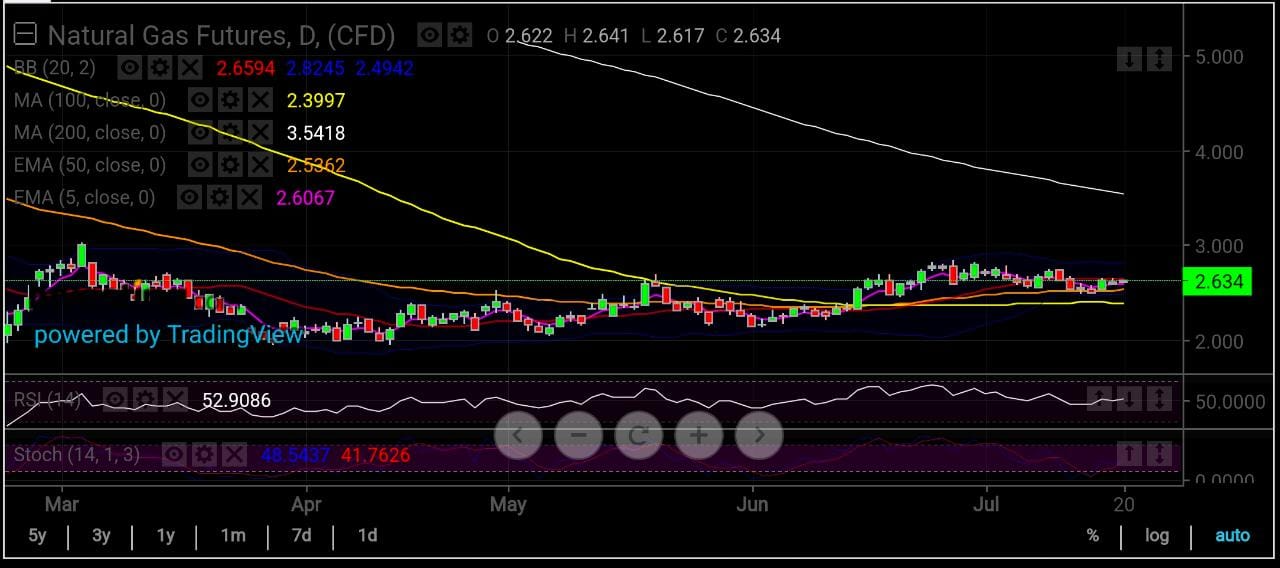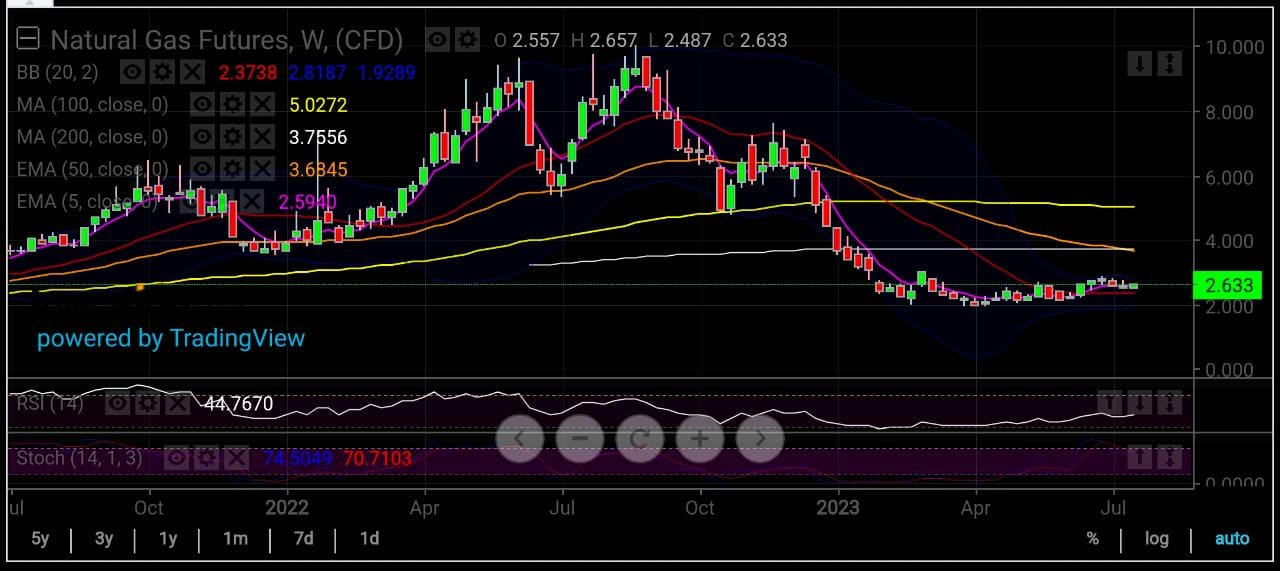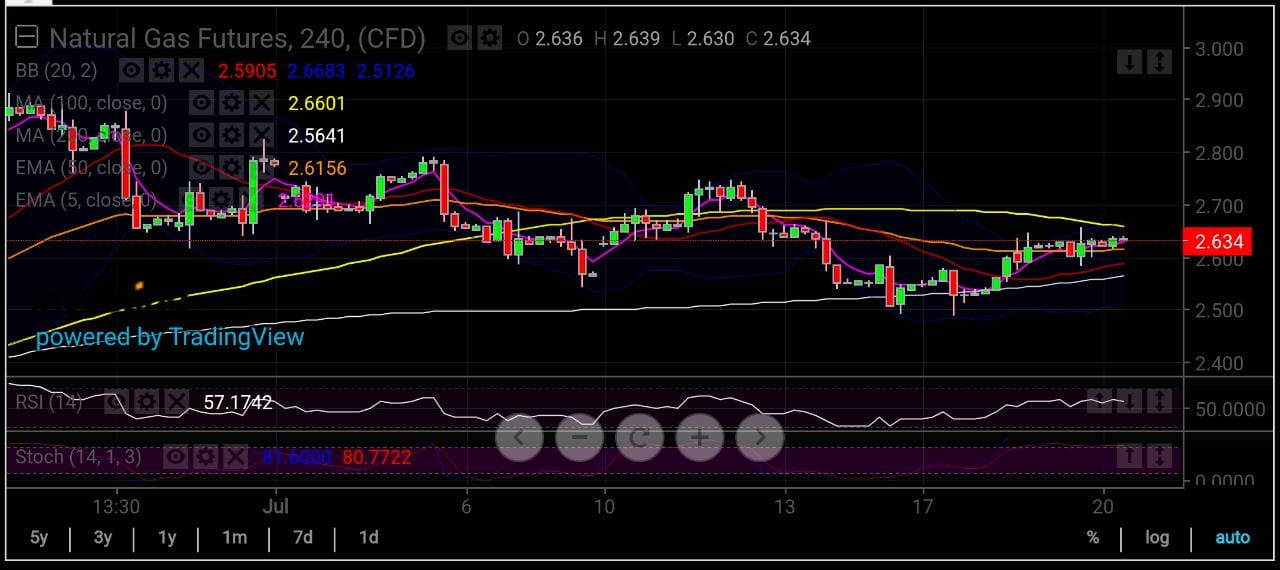- Debate on gas storage raises question of whether stockpile vs demand is too high
- Some analysts still see an oversupplied market, and need for more summer heat
- Gas has potential to go above $3, but must hold $2.37 support first
For the better half of the first half, the natural gas market felt like the same market though it got progressively better for longs in the game even if the weather didn’t at first.
With the first month of the second half nearly over now, something else has evidently improved though it isn’t making news the way production is: Storage.
According to S&P Global’s records, historically, “the lowest storage injection of the summer has come in the third week of July when the average weekly injection falls to just 31 bcf.” After which, it said builds get “progressively larger,” through the end of the injection season.
Last week, we got 40 bcf, or billion cubic feet, for the first week of July. Later today, the U.S. Energy Information Administration, or EIA, will provide the storage update for mid-July, which should bring us nearer to that 31-bcf target.
Charts by SKCharting, with data powered by Investing.com
Some in the trade are, however, challenging the so-called norm for storage cited by the S&P.
John Sodergreen, who publishes a weekly note on gas under the heading of “The Desk”, is one, arguing that a better term might be “incrementally, sorta larger,” from the five-year average low spotted during the first week of July.
The declining rig count in gas — immaterial thus far to higher production — could become material as shipments of LNG, or liquefied natural gas, ramp up, he says, adding:
“For the better part of ’23, supply has been going through a very significant set of shifts, meaning lower rig counts, but generally higher productivity. As of this month, however, our tea leaves suggest that the impressive productivity, through better technology or techniques, will no longer cover the huge year-on-year deficit of iron in the ground.”
Tighter Gas Market Coming?
In Sodergreen’s own words, he sees “natty production moving much lower” and outlines what else could be changing:
“As for exports, now that maintenance is largely over this summer, we can expect U.S. LNG operators to run flat out for the duration. And with the big heat on, not just here in the U.S., but also in the EU and Asia, demand will indeed continue to torque higher, as will prices. July should be viewed as the pivot month for supply, prices and general market dynamics. I’m pretty sure the term ‘loose’ won’t be bandied around all that much for the next 60 days in the natural gas space.”
To contextualize what he was saying, Sodergreen noted that just three months back, the year-on-year storage overhang was more than 33% and the overage to the five-year average topped 22%. Now, those numbers sit at 24% and 14%, respectively.
“Back in Q1 when our friendly meteorologist friends were first selling the hot Summer story, we were also reminded of how easy it had been in the past to carve enormous volumes of natural gas from storage when thermometers were glued to a certain upper level for extended periods. Like now, for example.”
Not all share his enthusiasm for a quick turnaround in market sentiment, though.
KPLER economist Reid I’Anson says crude production growth should be up more than 850,000 barrels year on year in 2023. He adds:
“My view is shifting on the longer-term outlook for U.S. shale. I think that output growth will be quite healthy over the next five years … Permian could see an additional 2 million barrels daily by [the] end of this decade.” I’Anson attributes that partly to the rise in associated gas, a by-product
Eli Rubin of EBW Analytics says that daily production has retreated from early-month highs toward levels more consistent with May output:
“It may be several weeks for more durable indications to signal that dry gas supply growth has begun to narrow into the back half of summer.” Despite a scorching back half of July — and trending hotter — “difficult comparisons to historic summer heat in recent years suggests storage surpluses may build versus the five-year average – potentially instituting a soft near-term ceiling for NYMEX futures.”
The most-active August gas contract on the Henry Hub of NYMEX, or the New York Mercantile Exchange, settled Wednesday at $2.603 per mmBtu, or million metric British thermal units — down 1% on the day but up 2.5% on the week. August gas peaked at around $2.90 earlier this month, marking the loftiest level for a front-month contract on the Henry Hub since March. Since then, it has returned to the mid-$2 levels it has been trapped for most of this year.
Potential Still Lurks for $3 Gas
August gas could still test $2.80 and beyond in the near term if positive momentum wins out, said Sunil Kumar Dixit, chief technical strategist at SKCharting.com. He explains:
“The mid-term outlook favors a bullish rebound supported by stability above the 50-day EMA, or Exponential Moving Average, dynamically positioned at $2.53 and waiting to break above the Daily Middle Bollinger Band of $2.66. The continuation of bullish momentum begins with a retest of the swing high of $2.84 followed by the psychological handle of $3.00.”
Dixit said strong acceptance above this zone will eventually extend gas’ rebound towards the 100-month SMA, or Simple Moving Average, of $3.25, followed by a confluence of the 50-week EMA of $3.68 and the 200-week SMA of $3.75.
“To astute observers, a careful study of the 4-Hour time frame of August gas indicates that short term price action will remain trapped within a tight range of 100 SMA $2.66 interim resistance and 200 SMA $2.56 immediate support. Current bullish momentum is subject to prices holding above the weekly Middle Bollinger Band statically aligned with $2.37. Range break awaits triggers from upcoming storage data.”
The storage report for the week ended July 14 is likely to show U.S. utilities adding a slightly above-normal build of 48 bcf, according to forecasters tracked by Investing.com.
That compares with a 35-bcf build during the same week a year ago and a five-year (2018-2022) average injection of 45 bcf.
In the week ended July 7, utilities added 49 bcf of gas into storage.
The forecast for the week ended July 14 would lift stockpiles to 2.978 trillion cubic feet, tcf, 24.3% above the same week a year ago and 14.1% above the five-year average.
Final Analysis: Lots More Heat Needed
Ryan Parsons of Gelber & Associates in Houston says that while the impact of fundamentals on supply and demand this week is relatively clear with higher demand and lower-to-flat supply:
“Near-term price movement is a function not only of supply-demand balance, but also market expectations, meaning the question must be asked, What is already priced into this market?”
He says that given high temperatures, near-peak demand have been forecast by analysts for many weeks now.
“We see a scenario in which major market entities have already positioned themselves for the upcoming heat, which would make the normally bullish impact of these fundamentals on price this week smaller than expected.”
Rhett Milne of NatGasWeather.com says the following two EIA reports, which cover the July 14-21 and July 21-28 periods are expected to print slightly smaller builds than the five-year average due to widespread heat across the United States the past week, although this was partially offset by stronger week-over-week wind energy generation.
And while sweltering weather is a constant now, it was still hotter in the previous summer.
“Going forward, a hot late July and August will be needed, along with tightening in the supply-demand balance, or surpluses will remain over 250-300 bcf going into fall.”
***
Disclaimer: The content of this article is purely to educate and inform and does not in any way represent an inducement or recommendation to buy or sell any commodity or its related securities. The author Barani Krishnan does not hold a position in the commodities and securities he writes about. He typically uses a range of views outside his own to bring diversity to his analysis of any market. For neutrality, he sometimes presents contrarian views and market variables.
